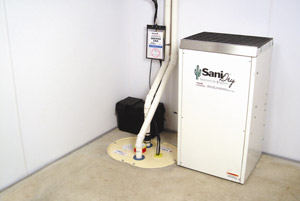
Mold Prevention
Use this 4-step plan to prevent mold from damaging your home and posing a serious health hazard

Mold or mildew?
Although these terms are often used interchangeably because they have the same harmful effects in your house, mold and mildew are separate types of fungi. Mold tends to have a fuzzy texture and can be green, black, brown, pink or purple in color. Mildew often starts out as yellow spots before turning black. It tends to be either downy or powdery.
Scientists still haven’t determined how many different species of mold there are, but estimates begin in the tens of thousands. In the outdoors, mold performs valuable recycling work, consuming dead organic material. However, all kinds of problems arise when mold comes indoors.
Mold colonies that take hold in dark, damp areas destroy furnishings and building materials and can even cause wood to rot. Mold’s telltale musty smell means that you’re breathing in airborne mold spores that can cause a wide range of allergic reactions and respiratory ailments.
To preserve property value as well as health, indoor mold needs to be stopped. However, this isn't easy to do. Mold can invade any home, regardless of house size, style and age. To prevent mold from being a major problem in your house, follow the four steps explained below.
Step 1: Learn why mold can be such a formidable foe
There’s excellent and extensive information about mold at the Center for Disease Control website. The short version of mold knowledge for homeowners goes like this: Mold grows best in dark, warm, damp conditions where food sources are present in the form of organic materials.
Inside a house, the most likely locations for mold growth are basements, crawl spaces and damp areas of kitchens and bathrooms. Mold’s favorite food is damp cellulose: wood and wood products, paper and fabric. A mold “colony” isn’t always visible; it can exist inside a wall cavity.
Mold can be killed using bleach and other biocides, but even after such treatments, there’s a strong likelihood that enough spores will survive to re-inhabit an area where favorable conditions are present. That’s why the remaining three steps are essential.
Step 2: Detect & correct moisture problems

Keeping a basement dry will discourage mold growth. An effective way to accomplish this goal is to install a high-quality TripleSafe sump pump system and a heavy-duty SaniDry™ dehumidifier and air cleaner. Both Basement Systems products are shown above.
Mold hates dry environments as much as it loves moist ones, so it’s critical to keep likely mold habitats dry. Make sure your basement has an effective waterproofing system. If your crawl space has a high moisture level because it’s vented to the outside, or because of a dirt floor, arrange to have the crawl space encapsulated to separate the house from these moisture sources. If building materials in your basement or crawl space are damp due to long-term exposure to moisture, it may be necessary to run a dehumidifier in the space so that these materials can dry out. Don’t use a light-duty “upstairs” dehumidifier, which isn't designed to handle basement and crawl space conditions.
Instead, specify a SaniDry® dehumidifier, which has an advanced air-cleaning filter that can capture mold spores while drying out the space. These advanced dehumidifiers enable you to maintain a low humidity level that makes it very difficult for new mold colonies to take hold.
Make sure all bathrooms are equipped with ventilation fans that effectively move moist air to the outside. Check carefully for plumbing leaks and make repairs if necessary.
If you are experiencing symptoms that could be caused by mold, like irritated eyes, nose, throat, or lungs, it's important to test for mold to find out if this is what is causing your health issues.
Step 3: Remove mold-damaged & mold-friendly materials
Instead of trying to kill and scour mold deposits on materials like gypsum board, carpeting and wood wall paneling, it’s usually better to remove and discard this contaminated material. This material has proven to be attractive to mold it the past and it may well be again in the future. Wood floor joists and other permanent features that have mold deposits will have to be cleaned in place, following recommended mold mitigation guidelines. Hiring a professional mold remediation contractor like your local Basement Systems dealer is your best option.
For long-term protection against mold, mold-friendly materials should be replaced with comparable materials designed to discourage mold growth. Common examples include replacing standard paper-faced drywall with gypsum board that’s faced with vinyl or fiberglass (inorganic materials that mold can’t consume), and replacing wood studs with steel studs. Basement Systems has developed a wide range of finish materials (flooring, wall panels, ceiling tiles, insulation) that contain no organic compounds to attract and nourish mold.
Step 4: Create & maintain a mold-hostile environment
By now you’ve gone a long way toward eliminating many of the conditions that are conducive to mold growth. Going forward, it’s important to continue these preventative practices. If you plan to finish your basement or remodel your bathroom, make sure to use quality mold prevention solutions like mold-resistant inorganic materials and a quality dehumidifier. Take advantage of the innovative mold-proof products from your Basement Systems dealer, like ThermalDry® flooring and BrightWall® wall panels.
Find a mold removal expert in your area who can repair all of your mold issues and prevent mold from damaging your home and health. Many Basement Systems, Inc. dealers offer Free Estimates! Contact us today to learn more.
Looking for a price? Get a no cost, no obligation free estimate.
